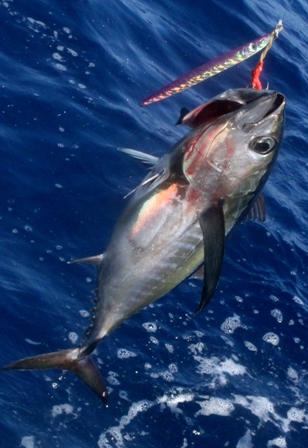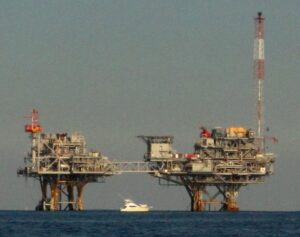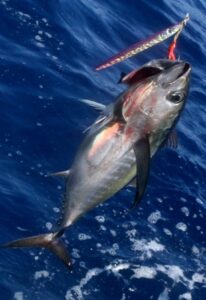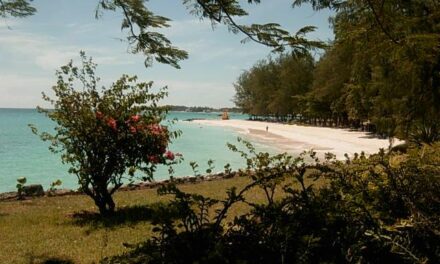Twenty miles off the coast of Louisiana’s Venice Marina, large fish swim around the gigantic legs of oil rigs. Barnacles, coral, and seaweed embrace the hefty concrete and steel that stretches close to three thousand feet along the Gulf of Mexico’s seabed. Dozens of fish and mammals nest in between the legs of the oil platforms, creating habitats that are unimaginable to both environmentalist and scientists. However, for fishermen and sea captains the artificial reefs present a golden opportunity.
Oil platforms boost the fishing industry
Louisiana has over 3,100 oil offshore platforms in the Gulf of Mexico that break water currents, leaving elbow room for fish to safely reproduce and mature. As large structures drill wells to extract and process oil and natural gas – up to one hundred thousand barrels per day – dynamic ecosystems that abound with various schools of fish flourish. Numerous subsea wells that are connected to platforms by flow lines create a safe haven for numerous species of fish.
“Oil rigs are pinnacle to the fishing industry,” says charter sea captain Chris Nail, who has been fishing for his entire life. “They are like truck stops for fish,” he adds.” Racing after pelagic fish that swim near the surface of the sea, he has caught over fifty species of fish, including blackfin and yellowfin tuna, amberjack, red snapper, barracuda, and king mackerel. Occasionally he goes after groupers and captures sharks by mistake
The Deepwater Horizon Oil spill
Because there is a wide range of ecosystems in the Gulf basin, some fishermen timidly protest against the oil rigs. They argue that last year’s Deepwater Horizon spill, which spread over ten million gallons of crude oil, caused little damage to the pelagic fish. The extent of the impact depends on how the oil spread, where it traveled, and how it was treated. Mitigation prevented some oil from washing ashore, while chemical dispersants broke down the rest.
Whatever British Petroleum (BP) failed to scoop up or burn sunk into the depths of the sea or was cleansed naturally, like mouthwash. Since the Mississippi River, the largest river system in North America, pumps trillions of gallons of fresh water into the Delta that clean the basin daily, it is
difficult to estimate environmental damage from the spill.
The accident occurred in waters with a high concentration of chlorophyll in close proximity to shore, causing less damage to the pelagic population, since fish such as tuna swim in blue waters with low concentrations of chlorophyll. Because tuna eat large amounts of bait fish to maintain their metabolism, they are reluctant to swim in areas with limited food sources, argues Captain Nail. “The stubborn ‘top dogs,’” the captain says, “avoided the spill as there was no food source, swimming more than a body length per second further upstream in strong currents.”
Waiting for the fish to bite
Sailing to the Gulf via the Tiger Pass route, Nail’s charter boat parks next to Medusa floater oil rig (Mississippi Canyon block 582) and waits for fish. The murky water, 2,200 feet deep, is colored a perfect shade of blue, unspoiled by leakage. An hour has passed and the fish are not eating live bait – small fish called “hardtails” – dangling from hooks behind the boat. Captured near buoys – floating markers found closer to shore – the blue runners give off an oily odor that appeals to tuna. Already several charter boats are losing patience and are heading for other rigs. A research boat from the Louisiana Department of Wildlife and Fisheries has also departed, unable to finish its study sponsored by BP. A few boats that have remained have won the golden trophy: yellowfin, weighing up to one hundred pounds. Persevering for a quarter of an hour, Captain Nail instead catches a twenty-pound blackfin and a large blue marlin with the bait.
He then sails the boat north about twenty miles to the continental shelf to fish nearby a few rigs in the West Delta, known for its numerous rigs and a few underwater salt domes. Pelicans scoop down to seize flying fish, while dolphins swim along a handful of boats. Hoping to catch a good-sized fish, Captain Nail throws chrome-colored fish dummies into the water. They are actually lead sinkers with hooks covered by a soft body to attract fish, attached to a rod that is jerked vertically. Sometimes the strong fish break the line, which is supposes to bear up to one hundred pounds of weight.
The crew regretfully captures red snappers the color of restaurant caviar, the six-week fishing window of which has already closed. They hook barracudas; the aggressive predators tear off some of the lines. “Fools!” the captain shouts. They also snatch silky sharks, almaco jacks, skipjack tuna, and amberjacks, which the team calls “rig donkeys” because of their strength and stubbornness in comparison to donkeys. Nail successfully captures a sixty-pound amberjack, using a line suspended close to three hundred feet.
Nail follows only one rule: the “law of averages.” “Sometimes you get lucky, sometimes you don’t,” he says, without coming home empty-handed. Hooking over thirty fish weighing eight hundred pounds in total, with a market value of up to $20 per pound (equivalent to the cost of the fuel), the captain and his crew have hit the bull’s eye.
Oil platforms help to monitor the environment
For a fishing industry that banks over $3 billion annually for the state, oil platforms are significant environmental stewards. The monstrous beasts reluctantly leave trash in their backyards, carefully monitoring every pump. They safely harbor countless fish populations that are not accounted for by leading experts.









